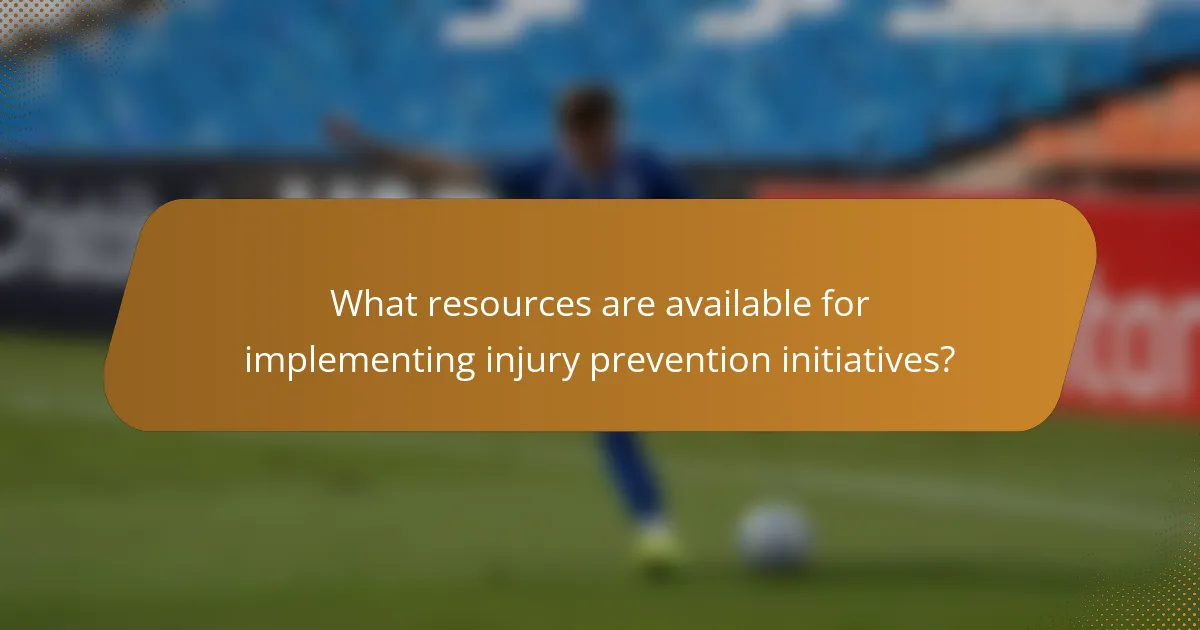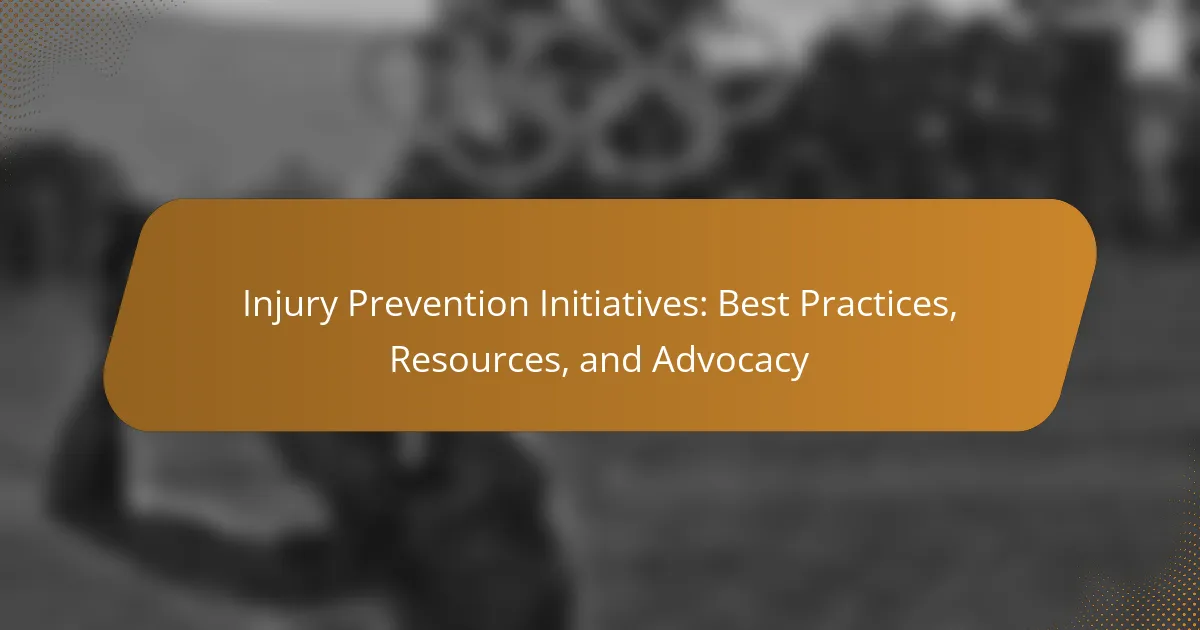Injury prevention initiatives are crucial for reducing accidents and enhancing community safety. This article explores best practices for effective strategies, highlights essential resources for implementation, and discusses the importance of advocacy in shaping policies. Key metrics for evaluating success will also be addressed, ensuring a comprehensive understanding of injury prevention efforts.

What are the key principles of effective injury prevention initiatives?
Effective injury prevention initiatives focus on education, community involvement, and data-driven strategies. Key principles include comprehensive risk assessment, targeted interventions, and ongoing evaluation. Collaboration with stakeholders enhances resource allocation and advocacy efforts. Engaging the community fosters awareness and participation, ultimately leading to sustainable injury reduction.
How do community engagement strategies enhance injury prevention?
Community engagement strategies significantly enhance injury prevention by fostering collaboration and awareness. These initiatives encourage local participation, leading to tailored solutions that address specific community needs. By involving stakeholders such as schools, healthcare providers, and local organizations, strategies can effectively disseminate information about safety practices and resources.
Moreover, community engagement often results in increased funding and support for injury prevention programs, as collective advocacy amplifies the message. Research shows that neighborhoods with active engagement see a reduction in injury rates, highlighting the effectiveness of these strategies.
In summary, community involvement creates a proactive approach to injury prevention, emphasizing localized efforts that resonate with residents and drive meaningful change.
Why is data collection vital for injury prevention efforts?
Data collection is essential for injury prevention because it identifies risk factors, informs strategies, and evaluates effectiveness. Accurate data helps stakeholders develop targeted interventions that reduce injuries. For instance, analyzing injury patterns can reveal high-risk environments, guiding resource allocation. Additionally, data-driven advocacy enhances public awareness and policy support, ultimately fostering safer communities.

Which best practices are recognized globally for injury prevention?
Globally recognized best practices for injury prevention include comprehensive strategies, community involvement, and evidence-based interventions. These practices aim to reduce injury rates effectively and sustainably.
Key practices involve implementing educational programs that raise awareness about safety measures. For example, promoting helmet use among cyclists significantly decreases head injuries. Additionally, engaging local communities in advocacy enhances the reach and impact of prevention initiatives.
Data-driven approaches are essential. Utilizing injury surveillance systems helps identify high-risk areas and populations, guiding targeted interventions. Collaborations between public health organizations and local governments foster resource sharing and strategic planning.
Regular evaluation of injury prevention programs ensures continuous improvement. By analyzing outcomes and adapting strategies, stakeholders can maintain effectiveness and address emerging challenges.
How do educational programs influence behavior change in injury prevention?
Educational programs significantly influence behavior change in injury prevention by enhancing knowledge, skills, and awareness. These initiatives often use interactive methods to engage participants, leading to improved adherence to safety practices. Evidence shows that well-structured programs can reduce injury rates by promoting proactive behaviors and reinforcing safety protocols. For instance, community workshops have been linked to a 30% decrease in sports-related injuries among youth.
What role do policy frameworks play in supporting injury prevention initiatives?
Policy frameworks are essential for supporting injury prevention initiatives by providing guidelines and resources. They establish standards that promote safety and allocate funding for programs. Effective frameworks also facilitate collaboration among stakeholders, ensuring a unified approach to injury prevention. Additionally, they help in evaluating the effectiveness of initiatives, which leads to continuous improvement and adaptation of strategies.

What resources are available for implementing injury prevention initiatives?
Numerous resources support the implementation of injury prevention initiatives. These include government guidelines, community programs, educational materials, and online databases.
Government agencies like the Centers for Disease Control and Prevention (CDC) provide comprehensive resources, including research, statistics, and best practice recommendations. Community organizations often offer training programs and workshops to raise awareness and implement strategies effectively.
Educational materials, such as manuals and toolkits, help stakeholders understand injury prevention methods. Online databases compile evidence-based strategies and resources for easy access.
Collaboration among these resources enhances the effectiveness of injury prevention efforts, leading to safer environments.
Which organizations provide funding for injury prevention projects?
Various organizations provide funding for injury prevention projects, including government agencies, non-profits, and foundations. Key sources include the Centers for Disease Control and Prevention (CDC), National Highway Traffic Safety Administration (NHTSA), and the Robert Wood Johnson Foundation. These entities focus on diverse aspects of injury prevention, such as road safety, workplace safety, and community health initiatives. Each organization offers unique funding opportunities tailored to specific projects and demographics.
How can technology be leveraged to support injury prevention efforts?
Technology can significantly enhance injury prevention efforts through data analytics, wearable devices, and educational platforms. Data analytics helps identify high-risk areas and trends, allowing for targeted interventions. Wearable devices monitor physical activity and biomechanics, providing real-time feedback to users. Educational platforms offer resources and training, raising awareness about safety practices. These tools collectively promote proactive measures, ultimately reducing injury rates.

What unique challenges do specific populations face in injury prevention?
Specific populations face unique challenges in injury prevention due to varying risk factors and access to resources. For example, older adults often struggle with mobility issues, increasing their risk of falls. Children may lack awareness of their surroundings, making them more susceptible to accidents. Individuals with disabilities might encounter barriers in accessing safe environments. Low-income communities often have limited access to preventive resources and education. Cultural differences can also impact the effectiveness of injury prevention initiatives. Addressing these challenges requires tailored approaches that consider the specific needs of each population.
How do cultural differences impact injury prevention strategies?
Cultural differences significantly influence injury prevention strategies by shaping perceptions, behaviors, and responses to risk. For instance, communities with strong collectivist values may prioritize group safety over individual actions, affecting policy implementation.
Additionally, language barriers can hinder effective communication of safety messages, leading to misunderstandings. Cultural beliefs about health and wellness can also impact acceptance of preventive measures. For example, some cultures may prefer traditional remedies over modern medical approaches, influencing the adoption of injury prevention practices.
Furthermore, cultural attitudes towards authority and compliance can affect how individuals respond to regulations and guidelines. In societies with high respect for authority, adherence to safety protocols may be more pronounced. Conversely, in cultures that value independence, individuals might resist imposed safety measures.
To enhance injury prevention initiatives, it’s crucial to tailor strategies to fit cultural contexts, ensuring they resonate with the values and norms of diverse populations.
What are the barriers to accessing injury prevention resources for marginalized communities?
Marginalized communities face significant barriers in accessing injury prevention resources. These barriers include economic constraints, limited awareness of available programs, and systemic inequities in healthcare access.
Economic constraints often lead to prioritizing immediate needs over injury prevention initiatives. Many individuals in these communities lack the financial means to invest in safety equipment or training programs. Limited awareness contributes to underutilization of existing resources; outreach efforts may not effectively reach these populations.
Systemic inequities in healthcare create disparities in access to preventive services. For instance, transportation issues can hinder attendance at workshops or clinics focused on injury prevention. Cultural and language barriers may also prevent effective communication about available resources.
Addressing these barriers requires targeted advocacy and tailored initiatives that consider the unique needs of marginalized communities. Fostering partnerships with local organizations can enhance outreach and resource distribution.

How can advocacy efforts improve injury prevention policies?
Advocacy efforts significantly enhance injury prevention policies by promoting awareness and mobilizing resources. These initiatives can lead to improved legislation, increased funding, and better community engagement. For example, successful advocacy campaigns have resulted in stricter safety regulations and public health initiatives that reduce injury rates. Engaging stakeholders fosters collaboration, ensuring diverse perspectives inform policy development. Additionally, data-driven advocacy highlights the effectiveness of specific interventions, encouraging evidence-based practices in injury prevention.
Which successful campaigns have influenced injury prevention legislation?
Successful campaigns that have influenced injury prevention legislation include initiatives like the “Click It or Ticket” campaign, which increased seatbelt usage and led to stricter laws. Another example is the “Stop the Bleed” campaign, promoting emergency response training, resulting in legislation for trauma care education in schools. These campaigns demonstrate effective advocacy through public awareness and legislative change, significantly impacting injury prevention.
What strategies can individuals employ to advocate for injury prevention in their communities?
Individuals can advocate for injury prevention by engaging in community education, collaborating with local organizations, and promoting policy changes. Effective strategies include organizing workshops to raise awareness, distributing informative materials, and leveraging social media to share safety tips. Building partnerships with schools and healthcare providers enhances outreach and credibility. Additionally, advocating for safer environments through community assessments can lead to impactful changes.

What metrics are essential for evaluating the effectiveness of injury prevention initiatives?
Essential metrics for evaluating the effectiveness of injury prevention initiatives include injury rates, program participation, cost-effectiveness, and community engagement. Tracking these metrics helps identify strengths and areas for improvement.
| Metric | Description |
|—————————-|———————————————–|
| Injury Rates | Measure of incidents before and after initiatives |
| Program Participation | Percentage of target population engaged |
| Cost-Effectiveness | Comparison of costs versus benefits |
| Community Engagement | Level of local involvement and support |
How can longitudinal studies inform future injury prevention strategies?
Longitudinal studies significantly enhance injury prevention strategies by identifying risk factors over time. They provide insights into injury patterns, allowing for targeted interventions. For instance, data from such studies can reveal how demographic shifts affect injury rates, informing resource allocation and advocacy efforts. Additionally, these studies help evaluate the long-term effectiveness of existing prevention initiatives, guiding future improvements. By understanding the progression of injuries, stakeholders can develop evidence-based practices that adapt to changing environments and populations.
Which indicators best reflect the success of injury prevention programs?
The success of injury prevention programs is best reflected by measurable outcomes such as reduced injury rates, increased awareness, and improved safety behaviors. Key indicators include the frequency of reported injuries, participation rates in prevention initiatives, and changes in community attitudes toward safety. Tracking these metrics allows for effective evaluation and continuous improvement of programs.
What are common pitfalls to avoid when implementing injury prevention initiatives?
Common pitfalls in injury prevention initiatives include lack of stakeholder engagement, insufficient data analysis, and failure to adapt strategies. Engaging all relevant parties ensures diverse perspectives and commitment. Analyzing data helps identify specific risks and measure effectiveness. Adapting initiatives based on feedback and outcomes is essential for continuous improvement. Neglecting these areas can lead to ineffective programs and increased injury rates.
